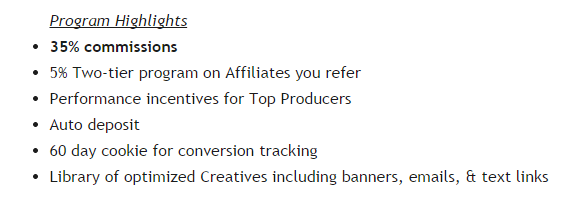 A few months ago I wrote a post that included an affiliate link to a WordPress theme. I actually don’t remember the name of the article and lost my password to the affiliate program, it was through ShareASale, but I get the sporadic check of 50 or so dollars from my effort.
A few months ago I wrote a post that included an affiliate link to a WordPress theme. I actually don’t remember the name of the article and lost my password to the affiliate program, it was through ShareASale, but I get the sporadic check of 50 or so dollars from my effort.
A throwaway link on a throwaway post is still generating money.
While 50 bucks isn’t big money, it’s enough to spur a little post explaining how to make money affiliate marketing.
I’ve gotten enough stupid emails about Amazon blogs and affiliate sites to warrant this article. Without further ado, here are a few of my basic observations:
1. Stop trying to sell cheap products off Amazon
I don’t bother writing book reviews anymore. If I read something I like I’ll reference it in a different article. Why? Because there is absolutely no way that I would ever recoup my time investment. Amazon pays between 4% and 8% on products you sell. That means each $10 book you move will only earn $0.40 to $0.80. Not exactly a huge payoff.
In 2013 I wrote a post reviewing 40 Alternatives To College. The article was pretty amateurish and less than 500 words.
Despite this I still sold 16 copies. Pretty cool, huh?
I thought so, until I looked at my affiliate commission.

My total earnings were less than a dollar!
It took me about an hour to write that article, I would have earned 10 times as much working some crummy retail job.
To make $4 to $8 per sale off Amazon you’d have to sell items in the $100+ range. Unless you’ve got some massive site traffic, promoting books or other inexpensive items isn’t worth your time.
2. A 70% commission on a $10 item is still less money than a 35% commission on a $100 product
The ShareASale program I’m in pays out a 35% commission. However, almost every item that I get paid for costs about $100. If I make two sales a month I get $70. In contrast, I’m also an affiliate for a few eBooks. These have higher payouts (some as much as 70%) but the overall product price is much lower. If I sell two $10 eBooks I get $14. That’s a huge difference in earnings.

Additionally I have the option of signing people up through my account so that they can become affiliates too. Whenever they sell something I get a 5% commission. If I were a smart man I’d withhold this information from you, make some grandiose claim about my earnings, write a long-form sales letter, and rope a bunch of naive teenagers into my little pyramid scheme. Unfortunately I’m not that clever.
Lastly, whatever product you’re selling should be of practical use to your audience. A 99% commission on a $3,000 unicycle course doesn’t mean anything if it’s being thrust upon people with no interest in the subject.
3. Stop reviewing products that don’t sell
In the section below I’ll expand on the “why,” but here’s the gist of it: To sell something there needs to be a demand. And the demand for books about picking up women or being more alpha is pretty low. Real Social Dynamics, the most “profitable” pick-up company out there, has a gross revenue of about 5 to 10 million dollars a year. That’s without expenses.
The business has been around since 2002, has over 100 employees, and sends instructors all over the world for various seminars. And they still aren’t earning anything. A regular business with a few dozen employees requires several million to run (source: my dad used to own a construction company with 20 employees).

Why bother selling a product no one wants?
The same goes for overcrowded markets. If every blog reviews a book, avoid it.
You aren’t missing much by not reviewing something that someone with a bigger following has already covered.
4. Understand that there are better ways to make money
I’m about to give you a little piece: What’s fun and what’s profitable aren’t always the same.
You really can’t monetize things like taking a nap or watching television. Otherwise everyone would be rich.
This doesn’t mean you have to work in a salt mine or do grueling tasks, but you do have to offer something that’s of actual value. Most of the websites you see fail to do this.
A few months ago I was getting ready to go to Vietnam. Before my trip I sat down with someone I look up to and asked them to look over a few “big name” websites. My mentor looked over them, checked to see how long they had been around, and then declared them “a waste of time.”
Without saying too much, a business that took three years to make $5,000 a month isn’t something you should emulate. It took me roughly two and a half months to break the $1,000 benchmark for my eBook business. And that’s something entirely independent from this blog.
Actual affiliate marketing, the kind done by guys like Eben Pagan, pays. But the classic blog model: Build a website and wait for traffic to arrive, is very poorly structured.
Offensive vs. defensive marketing
A regular business operates around the following principle: Find a market and create a product for it. A blog does the opposite. You build the market and then either find a product to sell or invent your own. It’s infinity more work.
For example, my dad and I were working on a product idea. There were two options (both of equal quality), release something that no one had ever heard about or create an item that was more traditional and easy to identify with. We chose the second option. Why? Because there’s a lot less explaining to do and you’ve already got a market. And when you already have a market you can focus on selling.
If we had two products, an Uhg-Shmoogler and a diet program, the diet program would be far more lucrative. You can sell it right out of the gate. The Uhg-Shmoogler, on the other hand, would take a lot of time to explain. You have to tell the audience what the product is, how it works, and why they want one. The diet program’s function is already understood and your “marketing” basically consists of pointing out all the product’s advantages over the competition.
Blogs, by and large, have the same problem as our fictitious Uhg-Shmoogler. It takes a lot of time to convince people to buy. You have to build your entire audience from the ground up. You’re waiting for the client to come to you. Essentially this is defensive marketing. After all, a “digital fortress” (as one braggart called it) is still a stationary lump that’s only effective when people cross paths with it. Even the Maginot Line was bypassed.
Offensive marketing is mobile and flexible. It also has a, comparatively, low investment. You aren’t sinking six months of effort into a project that hopefully pays off. Even when I’ve had a dud product, such as a book targeted towards SJWs, I wasn’t out a whole lot. You’re fluid and can adjust. That same dud eBook was slightly retooled and blasted at a different group.
A static blog can’t really do that. Good luck overhauling bestpotatopeelers.com when the market dries up.
When you’re targeting existing niches and tapping into their consumer base you save yourself a lot of time and wasted effort. I personally haven’t done much in the way of targeted affiliate marketing (the title of this post was intentionally misleading to get your attention and make you read on), but I have sold my own products to specific demographics. And from my experiences I can tell you that a specific niche is much more focused than what most guys would probably assume.
Some of the groups that I’ve marketed towards include: Potential entrepreneurs looking to create visual representations of their digital products, men who grew up in the 1980’s playing Cold War era hex-and-counter wargames, and women with a sexual fetish for Bigfoot.
Those are about as niche as you can get, but all of them are still susceptible to the same sales techniques.
Enter F.O.R.M.
In case you couldn’t guess, F.O.R.M. is an acronym. I learned about it in a sales book and it’s helped me out greatly. F.O.R.M. stands for the four “sales triggers” (sorry for the dorky jargon, I don’t know how else to explain it) that get people to buy. The basic idea behind it is that (almost) everyone is motivated by one of the following factors:
F – Family
If you’re selling board games to middle-aged men you’re selling them a piece of their childhood. Playing games with their friends, brothers, or parents. While you don’t have to get all sappy, you can reference the element of family fun that accompanies it.
O – Occupation
Business is the biggest aspect of many people’s lives. That could be a good thing, or it could be a source of stress. If you’re selling something to entrepreneurs you can mix the two together. “This product minimizes wasted time and lets you concentrate on the import aspects of your company.”
R -Recreation
There are plenty of people who prefer hobbies to work. Someone who wouldn’t spend an extra minute in the office will practice their golf swing for 10 hours straight. One of the nicest things about selling to hobbyists is the amount of money they spend. Things like board games or erotic novels about Bigfoot would fall into this category.
M -Money
Many people, myself included, have a weird fascination with earnings and profits. Show these people a chart or graph and you’ve got their full interest. If we were selling to entrepreneurs, like I was with my visual representation (which means you have one real version of the product and you wheel it out for photo ops) we could show a chart demonstrating that businesses with a physical item to show clients can make X amount more per day/month/year.
F.O.R.M. isn’t the most comprehensive sales system in the world, but it’s a good starting place. If I had to make any additions to it, I’d say that appealing towards people’s power fantasies is another good option. A lot of folks will buy something so that they can be superior to the people around them. Marketing to this instinct has worked for me in the past.
Closing thoughts
I just talked about a lot of stuff. And I didn’t outline this post before writing so we kind of went all over the place. because of this I’m going to quickly recap everything we just discussed:
- Cheap products with low commission rates should be avoided
- It’s easier to sell one $100 product than it is to move 10 $10 ones.
- If you think you’re going to make a lot of money off PUA books for “Alpha Males” you’re going to have a bad time
- Selling to an existing group is easier than bringing customers to you
- Selling to an existing group takes less effort
- Hone in on a niche
- Despite varied interests and backgrounds, most people will buy things for similar reasons